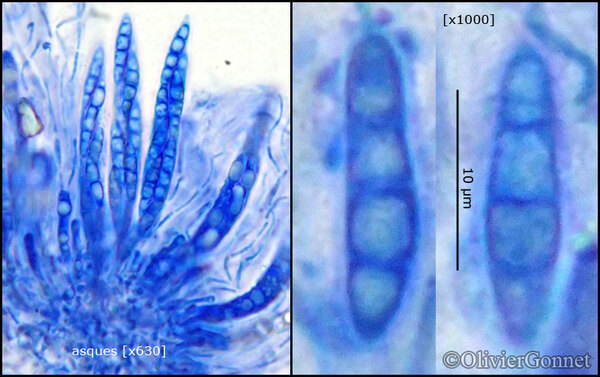Porina oxneri R. Sant.
Symb. Bot. Upsal., 12, 1: 221, 1952.
Synonyms: Phylloporina obsoleta Oxner; Pseudosagedia obsoleta (Oxner) Hafellner & Kalb
Distribution: C - Tosc (Puntillo & Ottonello 1997, Puntillo 2000), Umb (Ravera & al. 2011), Laz (Ravera 2006, 2006c). S - Camp (Puntillo & al. 2000, Puntillo 2000, Nimis & Tretiach 2004), Bas (Puntillo & al. 2012), Cal (Puntillo & Vezda 1994, Puntillo 1995, 1996, 2000, Puntillo & Puntillo 2004).
Description: Thallus crustose, thinly episubstratic, forming small, dispersed orbicular, up to 10 mm wide patches or more rarely continuous, smooth, pale grey to dark brownish grey, dull, without a distinct prothallus. Perithecia 0.15-0.25(-0.3) mm across, lenticular to hemispherical, not constricted at base, black to greyish-black, partly covered by hyphal tissue in lower part, the ostiole usually well-evident. Involucrellum 20-30 μm thick, black, K-; exciple prosoplectenchymatous, colourless to almost black, up to 15 μm thick; paraphyses simple or sparingly branched and anastomosing, c. 1 µm thick; hymenial gel I-, K/I-. Asci 8-spored, clavate, thin-walled throughout, functionally unitunicate, dehiscent by rupture of the apex, with no extruded inner layers and an apical ring structure, I-, K/I-. Ascospores 3-septate, hyaline, ellipsoid to fusiform with subobtuse ends, 13-20 x 3-4.5(-5) µm. Pycnidia up to 0.1 mm across, black. Conidia simple, bacilliform. 5-6 x 1-1.5 µm. Photobiont trentepohlioid. Spot tests: thallus K-, C-, KC-, P-. Chemistry: thallus without lichen substances.Note: an obligately foliicolous lichen, confined to warm-moist forests, on needles of Abies, leaves of evergreen trees and shrubs (e.g. Buxus), and cladodes of Ruscus; mainly Tyrrhenian in Italy. It is included in the Italian red list of epiphytic lichens as “Vulnerable” (Nascimbene & al. 2013c), although it seems to be quite widespread, albeit not common.
Growth form: Crustose
Substrata: leaves
Photobiont: Trentepohlia
Reproductive strategy: mainly sexual
Most common in areas with a humid-warm climate (e.g. most of Tyrrenian Italy)
Commonnes-rarity: (info)
Alpine belt: absent
Subalpine belt: absent
Oromediterranean belt: absent
Montane belt: very rare
Submediterranean belt: absent
Padanian area: absent
Humid submediterranean belt: extremely rare
Humid mediterranean belt: absent
Dry mediterranean belt: absent
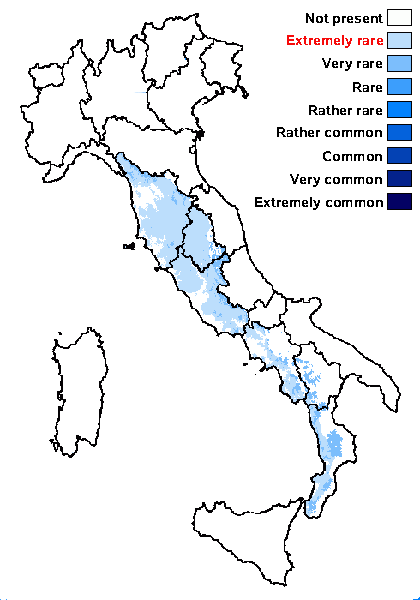
Predictive model
Herbarium samples


Felix Schumm - CC BY-SA 4.0
[VZR390], India. Insulae Andaman, Long Island,Lalajee Bay. Ad folia
arborunm. Leg. R. Detinský, 4.1998, det. A. Vezda. EX A. VEZDA:
LICHENES RARIORES EXSICCATI NR. 390.


Felix Schumm - CC BY-SA 4.0
[VZR390], India. Insulae Andaman, Long Island,Lalajee Bay. Ad folia
arborunm. Leg. R. Detinský, 4.1998, det. A. Vezda. EX A. VEZDA:
LICHENES RARIORES EXSICCATI NR. 390.


Felix Schumm - CC BY-SA 4.0
[VZR390], India. Insulae Andaman, Long Island,Lalajee Bay. Ad folia
arborunm. Leg. R. Detinský, 4.1998, det. A. Vezda. EX A. VEZDA:
LICHENES RARIORES EXSICCATI NR. 390.
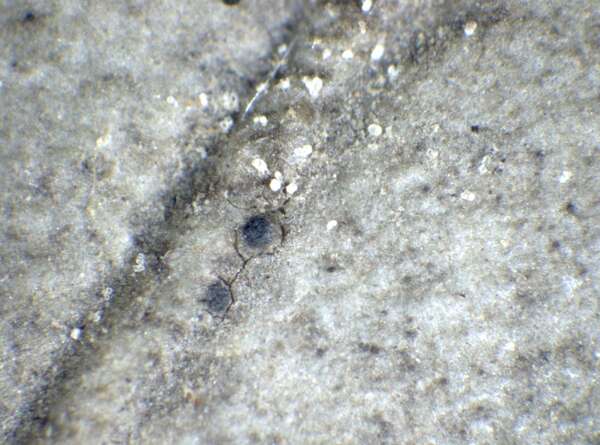

P.L. Nimis; Owner: Department of Life Sciences, University of Trieste
Herbarium: TSB (9113)
2001/11/29
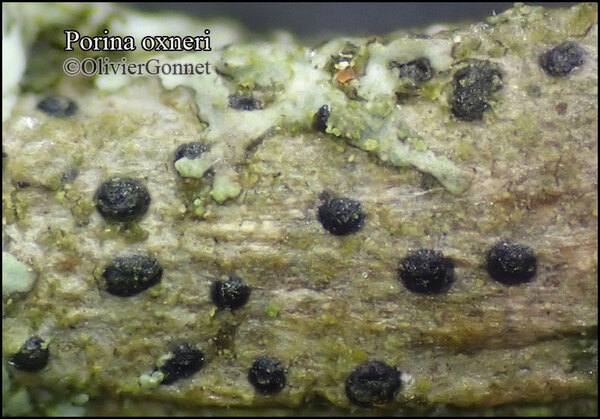
Courtesy Danièle et Olivier Gonnet - Source: https://www.afl-lichenologie.fr/Photos_AFL/Photos_AFL_P/Text_P_2/Porina_oxneri.htm
France, session 2014 dans le Parc du Mercantour
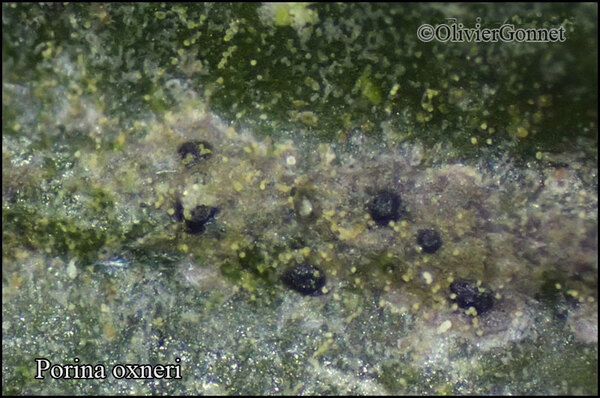
Courtesy Danièle et Olivier Gonnet - Source: https://www.afl-lichenologie.fr/Photos_AFL/Photos_AFL_P/Text_P_2/Porina_oxneri.htm
France, session 2014 dans le Parc du Mercantour
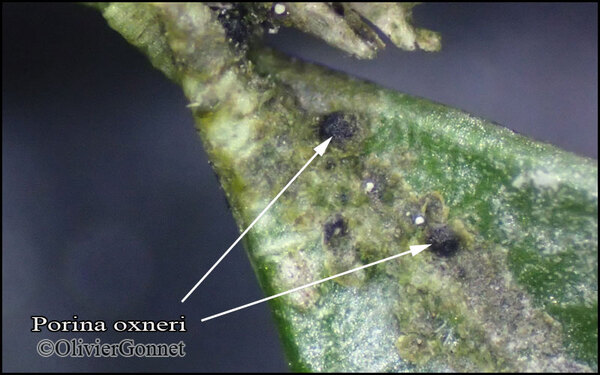
Courtesy Danièle et Olivier Gonnet - Source: https://www.afl-lichenologie.fr/Photos_AFL/Photos_AFL_P/Text_P_2/Porina_oxneri.htm
France, 2/6/2015 - Combe Lavaux, Côte-d'Or
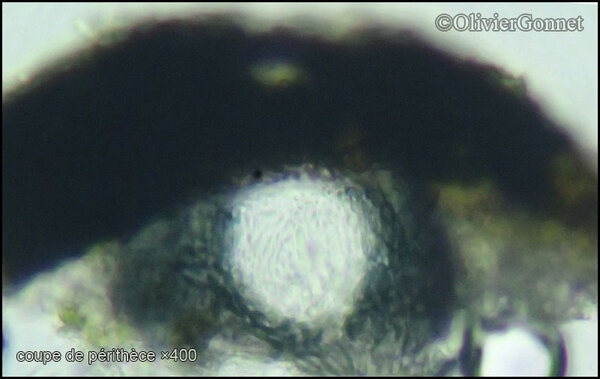
Courtesy Danièle et Olivier Gonnet - Source: https://www.afl-lichenologie.fr/Photos_AFL/Photos_AFL_P/Text_P_2/Porina_oxneri.htm
France, 2/6/2015 - Combe Lavaux, Côte-d'Or
Growth form: Crustose
Substrata: leaves
Photobiont: Trentepohlia
Reproductive strategy: mainly sexual
Most common in areas with a humid-warm climate (e.g. most of Tyrrenian Italy)
Commonnes-rarity: (info)
Alpine belt: absent
Subalpine belt: absent
Oromediterranean belt: absent
Montane belt: very rare
Submediterranean belt: absent
Padanian area: absent
Humid submediterranean belt: extremely rare
Humid mediterranean belt: absent
Dry mediterranean belt: absent

Predictive model
| Herbarium samples |


Felix Schumm - CC BY-SA 4.0
[VZR390], India. Insulae Andaman, Long Island,Lalajee Bay. Ad folia arborunm. Leg. R. Detinský, 4.1998, det. A. Vezda. EX A. VEZDA: LICHENES RARIORES EXSICCATI NR. 390.


Felix Schumm - CC BY-SA 4.0
[VZR390], India. Insulae Andaman, Long Island,Lalajee Bay. Ad folia arborunm. Leg. R. Detinský, 4.1998, det. A. Vezda. EX A. VEZDA: LICHENES RARIORES EXSICCATI NR. 390.


Felix Schumm - CC BY-SA 4.0
[VZR390], India. Insulae Andaman, Long Island,Lalajee Bay. Ad folia arborunm. Leg. R. Detinský, 4.1998, det. A. Vezda. EX A. VEZDA: LICHENES RARIORES EXSICCATI NR. 390.


P.L. Nimis; Owner: Department of Life Sciences, University of Trieste
Herbarium: TSB (9113)
2001/11/29

Courtesy Danièle et Olivier Gonnet - Source: https://www.afl-lichenologie.fr/Photos_AFL/Photos_AFL_P/Text_P_2/Porina_oxneri.htm
France, session 2014 dans le Parc du Mercantour

Courtesy Danièle et Olivier Gonnet - Source: https://www.afl-lichenologie.fr/Photos_AFL/Photos_AFL_P/Text_P_2/Porina_oxneri.htm
France, session 2014 dans le Parc du Mercantour

Courtesy Danièle et Olivier Gonnet - Source: https://www.afl-lichenologie.fr/Photos_AFL/Photos_AFL_P/Text_P_2/Porina_oxneri.htm
France, 2/6/2015 - Combe Lavaux, Côte-d'Or

 INDEX FUNGORUM
INDEX FUNGORUM
 GBIF
GBIF
